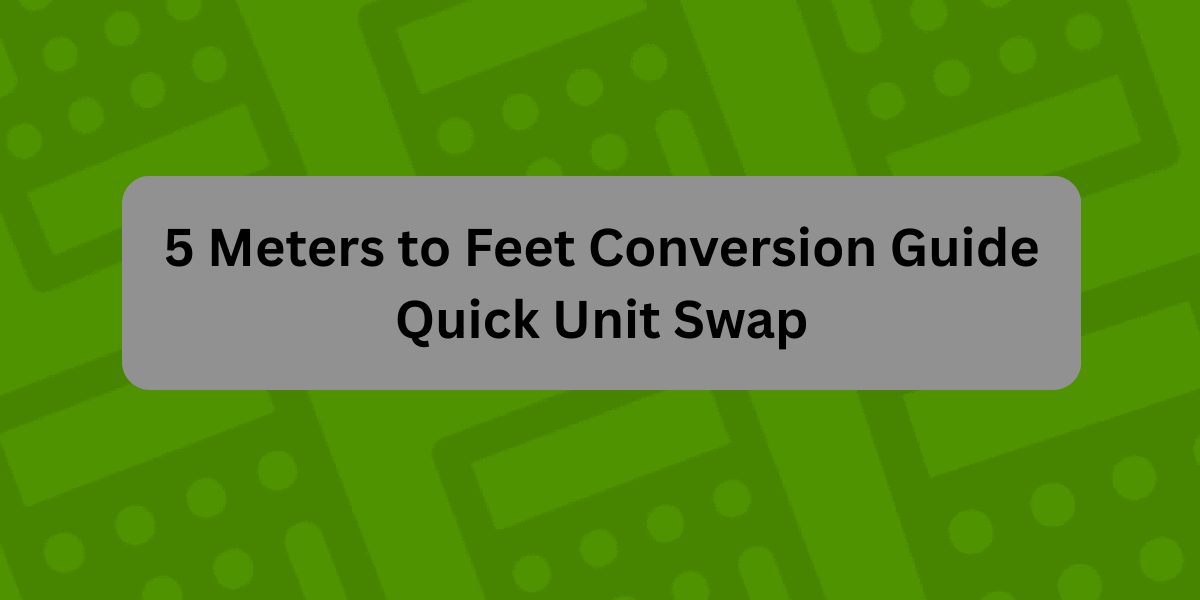Whether you’re working on a home renovation project, traveling to a country that uses the imperial system, or simply curious about metric-to-imperial conversions, knowing how to convert meters to feet is incredibly useful. One of the most commonly searched conversions is 5 meters to feet and for good reason.
This guide not only answers that question but also explains how the conversion works, offers real-world examples, and provides handy tools and formulas to make metric-to-imperial conversions effortless. By the end of this article, you’ll have a clear understanding of how to convert 5 meters to feet, along with useful tips to apply this knowledge in practical situations.
this is tool>Feet to Meters Converter
Understanding the Basics: What Is a Meter and What Is a Foot?
Before diving into the actual conversion, it’s essential to understand the units themselves.
What is a Meter?
- A meter (m) is the base unit of length in the International System of Units (SI).
- Widely used around the world, especially in science, engineering, and daily measurements.
- Defined as the distance light travels in 1/299,792,458 of a second.
What is a Foot?
- A foot (ft) is a unit of length in the Imperial and U.S. customary systems.
- Commonly used in countries like the United States for measuring height, room dimensions, and land.
- 1 foot = 12 inches.
Why Convert Meters to Feet?
Here are some common reasons:
- You’re measuring for home renovations using tools calibrated in feet.
- You’re studying or working in a country that uses imperial units.
- You’re comparing product specifications or property dimensions internationally.
The Simple Answer: 5 Meters to Feet
✅ Quick Conversion Answer:
5 meters = 16.4042 feet
This value is derived using the standard conversion factor:
1 meter = 3.28084 feet
🧮 Step-by-Step for 5 Meters:
- Take the number of meters: 5
- Multiply by 3.28084 (conversion factor)
- Result: 16.4042 feet
🔁 Reverse Formula (Feet to Meters):
This flexibility makes it easy to switch back and forth depending on your needs.
Real-World Examples of 5 Meters in Everyday Life
🏠 Home Improvement Made Simple: How Long is 5 Meters in Feet?
If you’re working on your home and need to figure out how long 5 meters is, here’s an easy way to picture it:
A wall that’s 5 meters long is about 16.4 feet. That’s roughly the size of a standard living room wall.
This length is great for things like:
- Placing a sofa and coffee table
- Mounting a large TV
- Planning a gallery wall with pictures or shelves
Knowing the size in feet helps if you’re buying furniture or décor from a store that uses feet instead of meters. It also makes it easier to talk to contractors or builders who might be more familiar with feet.
So next time you’re planning a makeover, just remember:
5 meters = 16.4 feet a good length for most living room setups!
🏃♂️ Sports & Fitness: Understanding 5 Meters Through Athletics
When it comes to sports and fitness, especially track and field events, knowing how long 5 meters is can be really helpful — and even eye-opening.
Let’s take the long jump as an example. In many schools and athletic fields, the long jump pit is around 5 meters in length. That’s about 16.4 feet. For beginner or intermediate athletes, a 5-meter jump is quite impressive!
Being able to visualize 5 meters gives athletes, coaches, and sports fans a better idea of the distances involved in real events. It’s not just a number — it represents:
- How far someone needs to jump in the long jump.
- The approximate distance someone might sprint in their first few strides out of the blocks.
- The length of some indoor training spaces or agility drills.
Here’s why this matters:
- 🏋️♀️ Fitness Goals: Knowing what 5 meters looks like helps when setting targets, especially in jumping, sprinting, or circuit training.
- 🧠 Motivation: Athletes can visualize their progress. “I just jumped almost 5 meters — that’s more than half the length of a car!”
- 🏆 Real-World Application: Whether you’re a student, a parent cheering from the sidelines, or a coach designing drills, understanding this distance helps everyone stay on the same page.
So, the next time you’re at the track or watching a sports event on TV, picture a space that’s 5 meters long (16.4 feet). It’s a meaningful distance — one that takes power, speed, and technique to master in athletics!
📸 Photography & Videography: Why 5 Meters Matters in Indoor Shoots
If you’re into photography or videography — whether as a hobbyist, content creator, or professional knowing how far 5 meters is can really make a difference in how your shots turn out.
In many indoor settings, a 5-meter distance (about 16.4 feet) is often seen as a sweet spot between the camera and the subject. This distance gives you enough room to:
- Capture full-body shots without distortion.
- Frame interviews or YouTube content with a clean, professional look.
- Get smoother focus and background blur (bokeh) in portrait shots.
- Avoid harsh shadows or glare by better positioning lights and reflectors.
Why is this range so popular?
- 🏠 Indoor-Friendly: In small to medium-sized rooms like living rooms, studios, or offices, 5 meters offers enough space to set up tripods, soft boxes, and backdrops without things feeling cramped.
- 🎥 Better Angles and Depth: Standing 5 meters away lets you play with angles and depth of field, especially if you’re using lenses between 35mm and 85mm.
- 🧍♂️ Comfort for the Subject: Subjects feel more relaxed when the camera isn’t too close. At 5 meters, you can direct them easily without making them feel self-conscious.
- 💡 Lighting Control: With more space, you have better control over artificial lighting setups — whether you’re using ring lights, LED panels, or soft boxes.
Pro Tip:
Use a lens with a bit of zoom (like a 50mm or 85mm prime lens) to make the most out of that 5-meter distance. You’ll get a sharp, focused subject and a nicely blurred background — perfect for portraits, product videos, or cinematic vlogs.
So next time you’re planning an indoor shoot, think about your space. Five meters is often the ideal range for clean, well-composed shots especially when you want to get that professional look without needing a giant studio.
🚗 How Long Is a Car Parking Space? Everything You Need to Know
A typical car parking space is about 5 meters in length, which equals 16.4 feet — useful for space planning in garages or driveways.
The Simple Answer: About 5 Meters or 16.4 Feet Long
A typical car parking space is around 5 meters in length. If you’re more familiar with feet, that’s roughly 16.4 feet long. This size is designed to comfortably fit most average-sized cars, from compact sedans to small SUVs.
Why Knowing Parking Space Size Matters
Understanding the size of a parking space can help you in many situations, such as:
- 🏠 Planning a home garage or driveway: You’ll want to make sure there’s enough space not just for the car, but also to open the doors and move around comfortably.
- 🚧 Building or designing parking lots: If you’re a developer or architect, using the right dimensions ensures cars can fit safely and easily.
- 🚗 Buying a new car: If you’re eyeing a larger vehicle like an SUV or pickup truck, knowing the average parking space size helps you figure out if it’ll fit in your space.
- 📦 Using your garage for storage: Measuring out how much space your car takes up allows you to plan better for shelves, bikes, or other stored items.
Quick Reference Conversion Table (Meters to Feet)
| Meters | Feet |
|---|---|
| 1 m | 3.2808 ft |
| 2 m | 6.5617 ft |
| 3 m | 9.8425 ft |
| 4 m | 13.1233 ft |
| 5 m | 16.4042 ft |
| 6 m | 19.685 ft |
| 10 m | 32.8084 ft |
Common Questions About Meters to Feet Conversion
❓ Is 5 meters longer than 16 feet?
Yes. Since 5 meters = 16.4042 feet, it’s slightly longer than 16 feet.
❓ Can I round the number when converting 5 meters to feet?
Yes. For quick estimates, you can round:
- 5 meters ≈ 16.4 feet
- Or even 5 meters ≈ 16 feet (if less precision is acceptable)
❓ Is the conversion factor always the same?
Yes. The conversion factor 1 meter = 3.28084 feet is a standardized and universally accepted value.
Pro Tips for Quick Unit Conversions
- Use a calculator app: Most smartphones have built-in unit converters.
- Install a measurement converter extension: For browsers like Chrome.
- Memorize key conversions: Know that 1 meter ≈ 3.28 feet for quick math.
- Use voice assistants: Just say, “Hey Siri, what’s 5 meters in feet?”
Recommended Tools & Resources
📲 Apps for Easy Conversion:
- Convert Units (iOS/Android)
- Unit Converter Pro
- Google Search (Type: “5 meters to feet”)
Visual Suggestion
To enhance clarity, you may include:
- Infographic: Comparison of 5 meters and 16.4 feet using objects (e.g., car, wall, track length).
- Ruler Overlay Image: Show what 5 meters looks like in feet with a side-by-side visual.
- Room Layout Plan: Visualizing furniture against a 5-meter wall.
👉 Alt Text Example: “A 5-meter wall visualized as 16.4 feet with sofa and TV placement.”
Conclusion: A Simple Swap That Makes a Big Difference
Understanding how to 5 Meters to Feet Conversion Guide can be incredibly helpful for day-to-day tasks, travel, academic work, and DIY projects. With the simple formula and handy tips provided in this guide, you’re now equipped to handle metric-to-imperial conversions with ease.
Whether you’re sketching a room layout or comparing international specs, remember:
Next time you’re faced with metric measurements, you’ll know exactly how to convert them quickly, accurately, and confidently.
this is tool Convert Inches to cm, mm, feet


